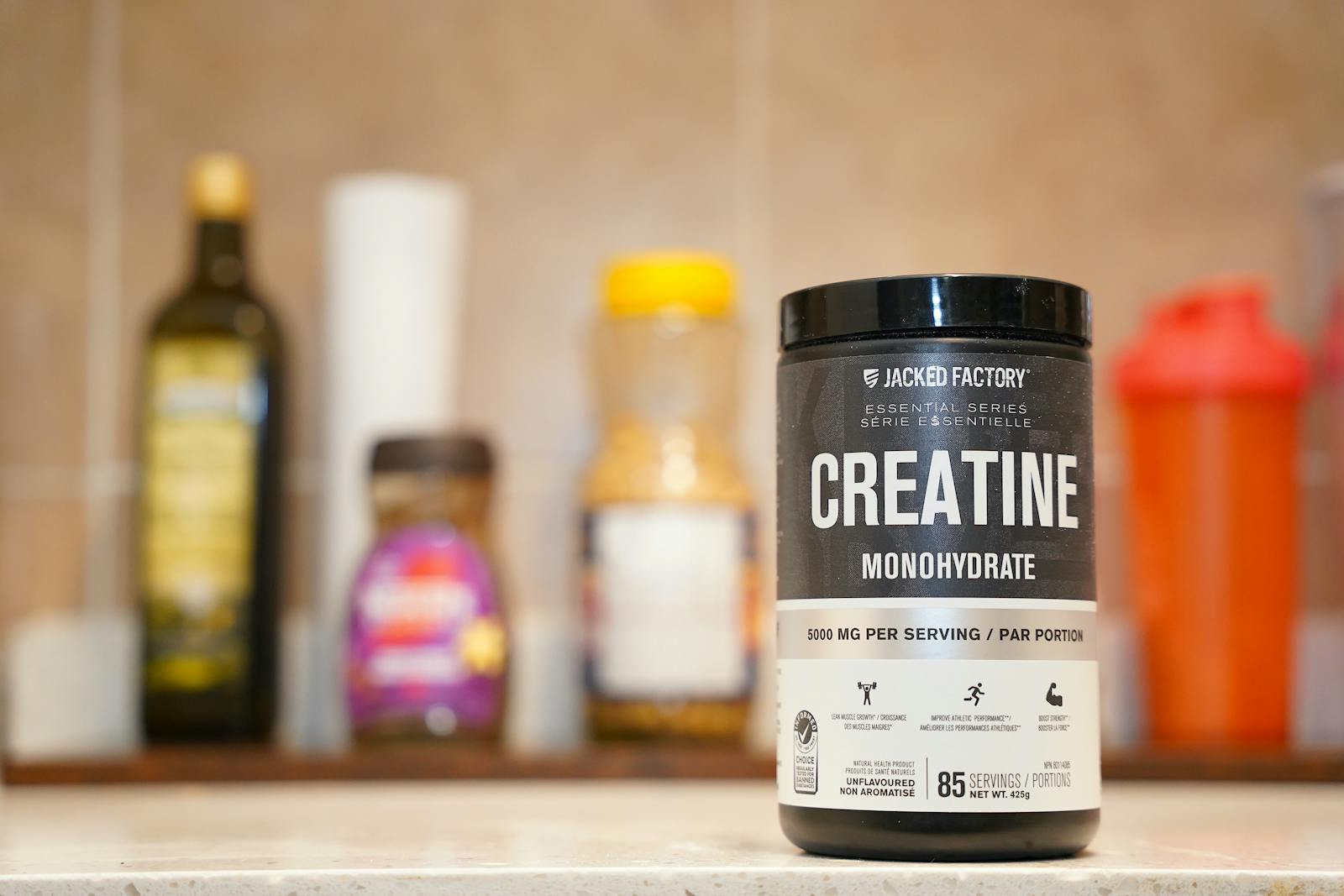Creatine: what it really is and why it matters
Creatine is a small, naturally occurring molecule your body produces and also gets from foods such as red meat and seafood. The vast majority of creatine in the body is stored in skeletal muscle as phosphocreatine, which acts as a rapid reserve to regenerate ATP — the cell’s immediate energy currency — during brief, intense efforts like heavy lifts, sprints, or jumps. That clear biochemical role explains why creatine reliably helps short-burst power and strength rather than long aerobic endurance. For a concise medical overview, see the Cleveland Clinic and Harvard Health guides, and the University of Essex summary of the research.
What the research actually shows
Across hundreds of studies, creatine monohydrate stands out as one of the most consistent and reproducible supplements in sports nutrition. When combined with resistance training, creatine increases maximal strength and power output, and it improves the ability to perform repeated high-intensity efforts. Those performance gains translate, over weeks and months, into greater training capacity and modest additional lean mass compared with training alone. Some of the early weight gain after starting creatine is simply water held inside muscle cells; longer-term increases in muscle size reflect greater training stimulus and favorable cell signaling.
Beyond muscles, creatine is taken up by the brain and has shown promising signals for cognitive performance, particularly in people with lower baseline creatine (for example, older adults and vegetarians). Researchers are also exploring creatine as an adjunct in clinical contexts — neurodegenerative diseases and certain muscle disorders — but those applications remain experimental and require more targeted trials before creatine becomes an established medical therapy.
Safety: what to expect and when to be cautious
For healthy adults, creatine monohydrate has an excellent safety profile when used at standard doses. The most common and expected effect is a small increase in body weight driven by intramuscular water retention. A minority of users report mild gastrointestinal discomfort; this is often avoided by splitting the daily dose or taking creatine with food. The public fear that creatine “ruins the kidneys” is not supported by the evidence in healthy people, but anyone with preexisting kidney or significant liver disease should consult their clinician before starting supplementation. Pregnant or breastfeeding people are typically advised to avoid creatine or seek medical guidance because safety data are limited. There are also case reports and theoretical concerns that creatine could affect mood stability in people with bipolar disorder, so psychiatric history is another reason to check with a clinician.
Practical dosing that actually works
If you want a simple, no-nonsense approach, use creatine monohydrate; it is inexpensive, well-studied, and effective. Two reasonable ways to use it are available. The first is a loading protocol to saturate muscle stores faster: take roughly 20 grams per day split into four equal doses for five to seven days, then move to a maintenance dose of 3–5 grams per day. The second is a simpler approach that skips loading entirely: take 3–5 grams per day from day one and allow stores to build over three to four weeks. Either approach reaches effective muscle creatine levels; the loading method just gets you there sooner. Timing matters much less than consistency, although taking creatine with a meal (or with some carbohydrate) can slightly improve uptake for some people.
Cutting through myths and marketing noise
Creatine is not an anabolic steroid, nor is it a mysterious performance potion that produces overnight miracles. It is a metabolite that supports energy regeneration during short, maximal efforts. The best-supported benefits come from pairing creatine with a structured training program and adequate nutrition; the supplement amplifies work you would otherwise do, it does not replace training. Also, you do not need expensive “next-gen” creatine forms; monohydrate is the gold standard. If you compete in drug-tested sport, buy products certified by third-party testing organizations to minimize the risk of contamination with banned substances.
Who benefits most and who should think twice
People who expect the largest, clearest benefits are those focused on strength, power, or sports that require repeated short, intense efforts. Older adults who want to preserve muscle mass and cognitive resilience and individuals who eat little or no meat (vegetarians and vegans) often experience larger relative improvements because baseline creatine stores tend to be lower. Conversely, people with known kidney or significant liver disease, those who are pregnant or breastfeeding, or people with certain psychiatric conditions should seek medical advice before starting creatine.
Buying tips and everyday use
When shopping, prioritize plain creatine monohydrate, ideally micronized for easier mixing if you dislike grit. Avoid proprietary blends and marketing claims that promise unrealistic transformations. Look for products that display third-party testing seals (for example NSF or Informed-Sport) if you need assurance about purity, especially as a competitive athlete. Start with a maintenance dose of 3–5 grams per day if you prefer simplicity, and keep a quick log of your weight, training loads, and any side effects during the first month so you can assess how you respond.
Bottom line — pragmatic and evidence-driven
If your goal is greater strength, better short-burst power, or improved recovery from intense training sessions, creatine monohydrate is a low-cost, high-value tool that consistently delivers. It’s not a magic bullet, but when used sensibly alongside progressive training and solid nutrition it reliably amplifies results. Be pragmatic about dosing, buy a reputable product, and check with your clinician if you have relevant medical issues. That’s the traditional, evidence-first playbook: simple, effective, and hard to beat.




